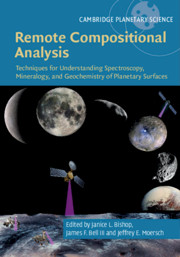 Remote Compositional Analysis
Remote Compositional Analysis from Part IV - Applications to Planetary Surfaces
Published online by Cambridge University Press: 15 November 2019
Asteroids represent a time capsule, storing information about the composition of and conditions in the solar nebula as well as processes that have affected the Solar System. The asteroid population includes primitive bodies, partially melted material, and the result of full melting and differentiation of planetesimals. Asteroidal minerals, organic molecules, and ices that are relevant to uncovering the history of the Solar System are accessible spectroscopically. Reflection and thermal emission spectroscopy from ground-based telescopes, space telescopes, and spacecraft provide a rich view of asteroid surfaces. Analysis techniques, including taxonomic classification, direct comparisons to meteorites and pure materials, band parameter analysis, and physical models of light scattering, are customized to the specific science question under study. In recent years, spacecraft missions to asteroids have provided ground-truth to more remote spectral analyses, corroborating many inferences from ground-based observations, while enabling new discoveries and a richer, deeper view of asteroid surfaces. These compositional studies provide an important complement to and constraint on dynamical investigations of Solar System evolution. The future of asteroid science is bright, with advances expected in the areas of sample return, additional reconnaissance missions, improved wavelength coverage spectroscopy, and significant increases in the size of the database of asteroid spectra.
To save this book to your Kindle, first ensure [email protected] is added to your Approved Personal Document E-mail List under your Personal Document Settings on the Manage Your Content and Devices page of your Amazon account. Then enter the ‘name’ part of your Kindle email address below. Find out more about saving to your Kindle.
Note you can select to save to either the @free.kindle.com or @kindle.com variations. ‘@free.kindle.com’ emails are free but can only be saved to your device when it is connected to wi-fi. ‘@kindle.com’ emails can be delivered even when you are not connected to wi-fi, but note that service fees apply.
Find out more about the Kindle Personal Document Service.
To save content items to your account, please confirm that you agree to abide by our usage policies. If this is the first time you use this feature, you will be asked to authorise Cambridge Core to connect with your account. Find out more about saving content to Dropbox.
To save content items to your account, please confirm that you agree to abide by our usage policies. If this is the first time you use this feature, you will be asked to authorise Cambridge Core to connect with your account. Find out more about saving content to Google Drive.